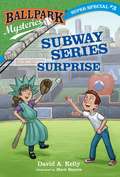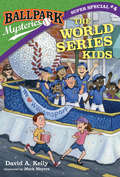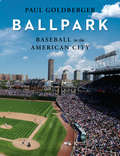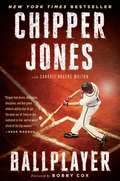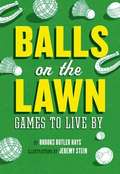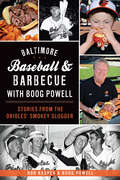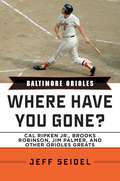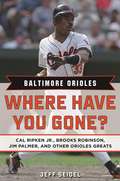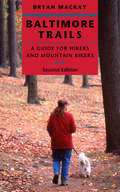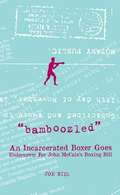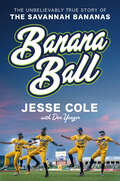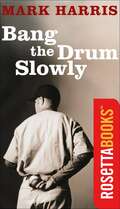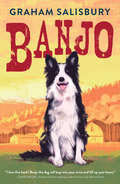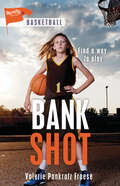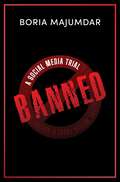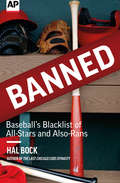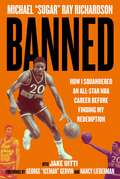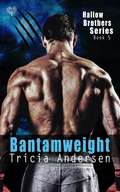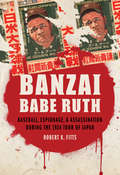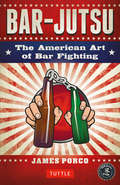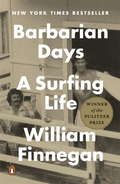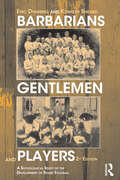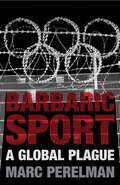- Table View
- List View
Ballpark Mysteries Super Special #3: Subway Series Surprise (Ballpark Mysteries #3)
by David A. Kelly Mark MeyersBatter up! It's an NYC-themed Super Special! Ballpark Mysteries are fun, accessible early chapter books that cross baseball action with puzzling whodunits!Catch a baseball mystery--in New York City! Mike and Kate are in for an extra special treat! Two hometown baseball teams in one city! A Subway Series is when the New York Mets play the New York Yankees, and Mike and Kate can't wait to watch all the action! But someone is playing pranks at both ballparks! And when Mike and Kate hear mysterious mumblings at the famous Whispering Gallery at Grand Central Terminal, they just might be able to catch the culprit before the series ends. A longer story, plus bonus backmatter with activities and NYC trivia, makes Subway Series Surprise a truly Super Special addition to the Ballpark Mysteries.
Ballpark Mysteries Super Special #4: The World Series Kids (Ballpark Mysteries)
by David A. KellyBatter up! Get ready to watch the kids' baseball team from Cooperstown compete in this Super Special edition of the Ballpark Mysteries--fun, accessible early chapter books that cross baseball action with puzzling whodunits! Catch a baseball mystery with the World Series Kids! The kids of Cooperstown made it to the World Series! Technically, Mike and Kate are just there to support their friend Colin and his teammates as they play for the championship. But the competition gets tricky when someone starts trying to sabotage Cooperstown's team--they punch holes in the tires of their bus, and the team's equipment goes missing! Can Mike and Kate find the trickster before it's too late? Or will these shenanigans cost Cooperstown the series?A longer story, plus bonus back matter with amazing baseball facts, make The World Series Kids a truly Super Special addition to the Ballpark Mysteries.
Ballpark: Baseball in the American City
by Paul Goldberger<p>An exhilarating, splendidly illustrated, entirely new look at the history of baseball: told through the stories of the vibrant and ever-changing ballparks where the game was and is staged, by the Pulitzer Prize-winning architectural critic. <p>From the earliest corrals of the mid-1800s (Union Grounds in Brooklyn was a "saloon in the open air"), to the much mourned parks of the early 1900s (Detroit's Tiger Stadium, Cincinnati's Palace of the Fans), to the stadiums we fill today, Paul Goldberger makes clear the inextricable bond between the American city and America's favorite pastime. In the changing locations and architecture of our ballparks, Goldberger reveals the manifestations of a changing society: the earliest ballparks evoked the Victorian age in their accommodations--bleachers for the riffraff, grandstands for the middle-class; the "concrete donuts" of the 1950s and '60s made plain television's grip on the public's attention; and more recent ballparks, like Baltimore's Camden Yards, signal a new way forward for stadium design and for baseball's role in urban development. Throughout, Goldberger shows us the way in which baseball's history is concurrent with our cultural history: the rise of urban parks and public transportation; the development of new building materials and engineering and design skills. And how the site details and the requirements of the game--the diamond, the outfields, the walls, the grandstands--shaped our most beloved ballparks. <p>A fascinating, exuberant ode to the Edens at the heart of our cities--where dreams are as limitless as the outfields. <p>This is a fixed-format ebook, which preserves the design and layout of the original print book.</p>
Ballplayer
by Bobby Cox Carroll Rogers Walton Chipper JonesAtlanta Braves third baseman Chipper Jones—one of the greatest switch-hitters in baseball history—shares his remarkable story, while capturing the magic nostalgia that sets baseball apart from every other sport. Before Chipper Jones became an eight-time All-Star who amassed Hall of Fame–worthy statistics during a nineteen-year career with the Atlanta Braves, he was just a country kid from small town Pierson, Florida. A kid who grew up playing baseball in the backyard with his dad dreaming that one day he’d be a major league ballplayer. With his trademark candor and astonishing recall, Chipper Jones tells the story of his rise to the MLB ranks and what it took to stay with one organization his entire career in an era of booming free agency. His journey begins with learning the art of switch-hitting and takes off after the Braves made him the number one overall pick in the 1990 draft, setting him on course to become the linchpin of their lineup at the height of their fourteen-straight division-title run. Ballplayer takes readers into the clubhouse of the Braves’ extraordinary dynasty, from the climax of the World Series championship in 1995 to the last-gasp division win by the 2005 “Baby Braves”; all the while sharing pitch-by-pitch dissections of clashes at the plate with some of the all-time great starters, such as Clemens and Johnson, as well as closers such as Wagner and Papelbon. He delves into his relationships with Bobby Cox and his famous Braves brothers—Maddux, Glavine, Smoltz, among them—and opponents from Cal Ripken Jr. to Barry Bonds. The National League MVP also opens up about his overnight rise to superstardom and the personal pitfalls that came with fame; his spirited rivalry with the New York Mets; his reflections on baseball in the modern era—outrageous money, steroids, and all—and his special last season in 2012. Ballplayer immerses us in the best of baseball, as if we’re sitting next to Chipper in the dugout on an endless spring day.
Balls on the Lawn
by Jeremy Stein Brooks Butler HaysThe serious leisure aficionado knows that it doesn't take much to transform a ho-hum afternoon into a truly memorable one--just a few balls, some mallets, maybe a horseshoe or two. The transformative nature of lawn sports takes center stage in Balls on the Lawn, an ode to classic outdoor activities, from the common (bocce) to the obscure (Kan-Jam). Including the history and complete rules of 10 iconic games, plus appropriate accompanying cocktails (serious leisure requires serious sustenance), Balls on the Lawn will revolutionize Saturday afternoons through the long-held traditions, robust competition, and abundant camaraderie of lawn sports.
Baltimore Baseball & Barbecue with Boog Powell: Stories from the Orioles' Smokey Slugger (American Palate)
by Boog Powell Rob KasperSince he started smacking long balls for the Baltimore Orioles, John "Boog" Powell has enjoyed the gustatory delights of his adopted hometown. A four-time All-Star and a fixture in two World Series, Boog also knows how to make one heck of a pit beef sandwich. Backyard barbecues at Boog's Baltimore row house were once a post-game tradition for the team. After hanging up his spikes, the former MVP set up his now iconic barbecue operation at Camden Yards. Baltimore author Rob Kasper takes a behind-the-scenes look at the life of this smoky slugger from his Florida boyhood through his rise to major-league glory and beyond. Told in Boog's colorful style, this rollicking journey is spiced with recipes and topped off with interviews from former teammates like Brooks Robinson, Frank Robinson and Jim Palmer.
Baltimore Orioles: Where Have You Gone? (Where Have You Gone?)
by Jeff SeidelBaltimore Orioles: Where Have You Gone? is a unique look at what a number of former Orioles personalities have gone on to do in life since their playing careers ended. Author Jeff Seidel spoke with a wide-ranging number of former Baltimore players, from stars like Cal Ripken Jr. and Brooks Robinson, to those who had only their "15 minutes" of fame, like Dave Criscione and John Stefero. A common thread seems to be how many of the former Orioles stayed in baseball in some form, like Ripken, who started his own minor league team in Aberdeen, Maryland, something that's clearly close to his heart; or former catcher Andy Etchebarren, a longtime minor league manager and coach.Baltimore Orioles: Where Have You Gone? features men like Mike Flanagan, the Cy Young Award-winning lefty who anchored the Orioles pitching staff in the late '70s and early '80s, finally becoming the team's pitching coach and co-general manager. The book also includes a chapter on Tommy Davis, the team's first designated hitter, who tells how he came up with a key base hit after nearly missing his at-bat because he was talking on the clubhouse telephone; Doug DeCinces, faced with the cruel task of taking over for Brooks Robinson at third base, talking about the huge pressure he faced and how he truly appreciated playing for the Orioles; and finally the legendary Robinson himself, still a fan favorite over 35 years after retiring, telling how he told the Chicago White Sox thanks, but no thanks, when they asked him about managing. It's all here; perfect for any Orioles fan!
Baltimore Orioles: Where Have You Gone? Cal Ripken Jr., Brooks Robinson, Jim Palmer, and Other Orioles Greats (Where Have You Gone?)
by Jeff SeidelBaltimore Orioles: Where Have You Gone? is a unique look at what a number of former Orioles personalities have gone on to do in life since their playing careers ended. Author Jeff Seidel spoke with a wide-ranging selection of former Baltimore players, from stars like Cal Ripken Jr. and Brooks Robinson to those who had only their “fifteen minutes” of fame, like Dave Criscione and John Stefero. A common thread seems to be how many of the former Orioles stayed in baseball in some form, like Ripken, who started his own minor league team in Aberdeen, Maryland, something that’s clearly close to his heart; or former catcher Andy Etchebarren, a longtime minor league manager and coach.Baltimore Orioles: Where Have You Gone?, first published in 2006 and newly updated through the 2016 season, features men like Mike Flanagan, the Cy Young Award–winning lefty who anchored the Orioles pitching staff in the late ’70s and early ’80s, finally becoming the team’s pitching coach and co–general manager. The book also includes a chapter on Tommy Davis, the team’s first designated hitter, who tells how he came up with a key base hit after nearly missing his at-bat because he was talking on the clubhouse telephone; Doug DeCinces, faced with the cruel task of taking over for Brooks Robinson at third base, talking about the huge pressure he faced and how he truly appreciated playing for the Orioles; and finally the legendary Robinson himself, still a fan favorite over 35 years after retiring, telling how he told the Chicago White Sox thanks, but no thanks, when they asked him about managing. It’s all here; perfect for any Orioles fan!
Baltimore Trails: A Guide for Hikers and Mountain Bikers
by Bryan MacKayBaltimore Trails is a comprehensive and detailed guide to trails on public lands in and around Baltimore. Discover Hemlock Gorge, a small slice of Appalachia transported into northern Baltimore County, with its timeless peace and ancient gnarled hemlocks; or Black Marsh, where birds skulk among the vegetation of pristine freshwater wetlands; or the unique landscape of Soldiers Delight Natural Environment Area, which shelters more than 38 rare plant species. Baltimore Trails answers the needs of hikers and mountain bikers, offering accurate maps, up-to-date access information, and reliable trail descriptions.Bryan MacKay, a lifelong Baltimore resident and avid naturalist, walked, cycled, and explored nearly 80 trails in local state, county, and city parks, as well as area watersheds. He provides a detailed description, topographic map, and the length, location, and degree of difficulty for each trail. Some trails offer an easy afternoon stroll, while others provide a day of rugged hiking or biking. Thumbnail essays offer scenic highlights and discuss typical plants, animals, and local ecology.Every trail was field-checked in 2007 for the second edition. Miles of new trails are included, as is updated information on recent trail reroutes.
Bamboozled
by Joe Biel Joey TorreyIn this introspective exploration of former boxer Joey Torrey's life, his past, his murder conviction, and his more than 30-year incarceration in a California state prison are each fine-tooth combed. Nearly five years after his original memoir, this new edition is re-written as a biography and delves deeper into circumstances surrounding Torrey's alleged murder of his boxing coach, the lengthy prison sentence handed down, his undercover collaboration with the FBI on "Operation Matchbook" in support of John McCain's proposed Professional Boxing Amendments Act, and the inner workings of the prison system in general. From his days as a Compton gang leader and an Olympic boxing hopeful to being tried as an adult rather than a 17-year-old minor, this compelling narrative reflects on his life as a parable as well as examining the strategies used in his conviction, such as establishing the motive as robbery despite a lack of evidence linking the opening of safe to the murderer. And after more than three decades as a model prisoner-and saving the life of a prison guard-Torrey has prolifically written hundreds of letters to Joe Biel, who finds himself in the unlikely situation to share this story.
Banana Ball: The Unbelievably True Story of the Savannah Bananas
by Jesse ColeThe Savannah Bananas have peeled back the game of baseball and made it fun again. This is their story. For his entire childhood, Jesse Cole dreamed of pitching in the Majors. Now, he has a life in baseball that he could have only imagined: he met the love of his life in the industry; they shaped Savannah, Georgia&’s professional team into the league champion Savannah Bananas; and now the Bananas have restyled baseball itself into something all their own: Banana Ball. Fast, fun, and outrageously entertaining, Banana Ball brings fans right into the game. The Bananas throw out a first banana rather than a ball. Their first-base coach dances to "Thriller" or Britney between innings. Players run into the crowd to hand out roses. And the rules themselves are bananas: if a fan catches a foul ball it&’s an out; and players might go to bat on stilts or wearing a banana costume. And their fans absolutely love it. But the reason this team is on the forefront of a movement is less about the play on the field and more about the atmosphere that the team culture creates. For the first time in this book, Jesse reveals the ideas and experiences that allowed him to reimagine America&’s oldest sport by creating a phenomenon that is helping fans fall in love with the game all over again. This is a story that&’s bigger than baseball and bigger than the yellow tuxedo Jesse wears as the &“ringmaster&” of every game. And to understand the movement, you have to understand the story at its core. In Jesse&’s telling, it takes heart, innovation, and joy (and a bit of tropical fruit) to make something wholly original out of one of America&’s great traditions. His story is part Moneyball, part Field of Dreams, part The Greatest Showman. It is a personal story, a creativity story, and the story of a business scrapping for every success. And it has several distinct love stories—love stories like Jesse and his father, Jesse and his wife, the team and the sport of baseball, the team and the fans. This is Jesse calling his dad from the outfield after each Bananas game, and putting unending creativity into a team with the ultimate goal of bringing the Bananas to the professional ballparks he himself never got to play in. This is his story of baseball, love, leadership, and going just a bit bananas for all.
Banana Bats and Ding-Dong Balls: A Century of Unique Baseball Inventions
by Dan GutmanAnecdotes describing various baseball inventions.
Banana Blade (Fountas & Pinnell Classroom, Guided Reading)
by Will LipsettNIMAC-sourced textbook. A BROKEN STICK. What would you do if your hockey stick broke just as you skated onto the ice to play? Stan Mikita, a pro hockey player, decided to use his broken stick anyway. His decision changed the game of hockey forever.
Bang the Drum Slowly
by Mark HarrisBang the Drum Slowly is the second in a series of four novels written by Mark Harris that chronicles the career of baseball player Henry W. Wiggen. This series is among the finest novels ever written to use baseball as a theme. Published in 1956, the book is a simple, moving testament to the immutable power of friendship. The title page in the novel reads; "by Henry W. Wiggen / Certain of His Enthusiasms Restrained by Mark Harris", the author's personal touch that tells us (the reader) that we are about to enter a genial, conversational first-person story. Wiggen is a gifted pitcher in the major leagues, playing for a team that includes a mediocre catcher named Bruce Pearson--a slow-talking Georgia boy who tries the patience of the team. Pearson has a secret; he has been diagnosed with Hodgkins' disease which threatens not only his life but also the baseball career that he so desperately wants. When Wiggen learns of Pearson's illness, their casual acquaintanceship deepens into a profound friendship. Wiggen fights heroically to keep Pearson on the team, saving his friend from being sent down to the minors, and he also rallies other teammates to help his friend. The miracle is that Pearson is transformed into a better ballplayer... but the miracle is brief for the man's time has already run out. In lesser hands, this story could be cloying or overly sentimental, but Harris writes with a gentle, unassuming dignity. Wiggen is an engaging character and his observations are lucid and refreshing. It may be that what makes Bang the Drum Slowly a great novel is that it is not entirely a sports novel but also a warm human comedy set in the familiar, magical world of American baseball. Bang the Drum Slowly is #14 on the Sports Illustrated Greatest 100 Sports books. ABOUT THE AUTHOR Mark Harris (1922) wrote novels for more than fifty years. He is best known for four novels about the life of major-league baseball player Henry W. Wiggen, including The Southpaw (1953) and Bang the Drum Slowly(1956) He also wrote the screenplay for the film version of Bang the Drum Slowly. In 1946, Harris made a splash with his first novel, Trumpet to the World, a book about a young black soldier who married a white woman. Many of Harris's other novels have dealt with academic life, and yet more of his novels are highly informed by autobiographical experience. Harris has also published a collection of his articles entitled Short Work of It, as well as the play Friedman and Son and a unique biography of Saul Bellow. SERIES DESCRIPTIONS From classic book to classic film, RosettaBooks has gathered some of most memorable books into film available. The selection is broad ranging and far reaching, with books from classic genre to cult classic to science fiction and horror and a blend of the two creating whole new genres like Richard Matheson's The Shrinking Man. Classic works from Vonnegut, one of the greatest writers of the twentieth century, meet with E.M. Forrester's A Passage to India. Whether the work is centered in the here and now, in the past, or in some distant and almost unimaginable future, each work is lasting and memorable and award-winning.
Banjo
by Graham SalisburyIn the spirit of of Where the Red Fern Grows and Because of Winn Dixie, this is a contemporary classic in the making about a boy and his dog, and a choice that will test their loyalty and trust.Danny Mack is a rising rodeo star in rural Oregon. He lives on a ranch with his older brother, their dad, and his faithful border collie, Banjo.Late one night, Danny is awakened by gunshots. Banjo has been wounded. The neighbors claim he was going after their livestock, which gives them the right to shoot the dog or have him put down. Dad reluctantly agrees. They must obey the law. Danny knows Banjo is innocent, and comes up with a desperate plan to save him--but something goes terribly wrong.Days later, on a distant ranch, Meg Harris finds a frightened dog alone in the woods. Banjo. She takes him home and searches for the dog's owner, furious that he was abandoned. She's not going to give Banjo up easily.Told by Danny and by Meg, this fast-paced, heartrending novel explores the deep connection between humans and animals, and reminds readers that you can't judge an animal--or a person--before you know their story.
Bank Shot (Lorimer Sports Stories)
by Valerie Pankratz FroeseThis girls' basketball story deals with the conflict between family caregiving responsibilities and extra-curricular sports that some kids, particularly girls, often face. Jo loves playing basketball in gym class and she is surprised when she makes the school team. Because she has to babysit her younger brother, she's afraid her mom will make her give up her place on the team, so instead, Jo hatches a plan to have a neighbor secretly babysit so she can play. While Jo shows initiative and problem-solving skills both on and off the court, will her mom see it that way when she's found out? Distributed in the U.S by Lerner Publishing Group.
Banned: A Social Media Trial
by Boria MajumdarA social media trial can break you. There were 100,000 tweets of abuse for days on end, all premised on a set of untruths pushed by someone hugely powerful because he had played for the national team. Against the entitled, I never stood a chance. The online trial forced me and the family to draw on every last bit of inner strength, and yet left permanent scars. Having served the ban, I wanted closure in the form of this book. But no one knows better that there will never be a full stop. I will not get back the two years of opportunities that I lost, or the days and evenings when I was almost a stranger to my daughter. For two years, my wife and I never had a quiet dinner where we could just relax. There was not one evening when we didn&’t discuss the issue and the book. Which outsider can quantify the impact it had on the mental health of my family? On my wife, my mother, my sister and my daughter? I became cynical about a number of things, and it will be tough to change that. Writing this book and putting the truth out there has drained and exhausted me. The truth is that the falsehoods piled up against me, ratified by all-knowing social media trolls, changed my life and that of my family. There is no going back to what we were. This was our Long Covid.
Banned: Baseball's Blacklist of All-Stars and Also-Rans
by Hal Bock The Associated PressAward-winning Associated Press sports writer Hal Bock brings us a fascinating history of the players, coaches and more barred from baseball's ranks, from Shoeless Joe Jackson to Jenrry Mejia. "Banned: Baseball's Blacklist of All-Stars and Also-Rans" weaves together tales of lesser-known characters from baseball's early years with infamous outlaws who have endured throughout the decades. Featuring stories of players like Eddie "The Only" Nolan, Cozy Dolan, Leo Durocher, and Pete Rose who have been expelled or suspended from the sport, Bock's chronicle delves deep into baseball's colorful history. For those who follow the current corporate era of businessmen players and billionaire owners, this book serves as a reminder that America's Pastime evolved from the days when gamblers filled the stands and influenced poorly paid scoundrels on the diamond.In his over 40-year career, Hal Bock has covered every major event on the sports calendar, including 30 World Series, 30 Super Bowls and 11 Olympic Games, making him the perfect storyteller for this retrospective. Featuring an introduction by John Thorn, the Official Historian of Major League Baseball, and more than 25 photographs from the Associated Press archives, "Banned" is a must-read for any fan of the game.
Banned: How I Squandered an All-Star NBA Career Before Finding My Redemption
by Jacob Uitti Michael Ray RichardsonMichael Ray Richardson was a star in the making. After a stellar collegiate career at the University of Montana, where he was voted first team All-Big Sky Conference as a sophomore, junior, and senior, the future seemed bright. Taken fourth overall in the 1978 NBA Draft by the New York Knicks, Richardson was billed as &“the next Walt Frazier.&” In just his second professional season, he became the third player in NBA history to lead the league in both assists and steals—both Knicks team records. Richardson would also notch four All-Star appearances and twice being named to the All-Defensive team over eight seasons between the Knicks, Golden State Warriors, and New Jersey Nets. But during that time, his time off the court was having a bigger impact on his career than what he was doing on the court. On February 25, 1986, after three violations of the league&’s drug policy, NBA commissioner David Stern would ban Richardson from continuing his professional career. His struggles with drugs and alcohol were well documented, and someone considered the next big thing became the first player in league history to be receive a lifetime ban. For most people, this would be the end to their story—one in which their substance abuse would take over and their downfall inevitable. However, that was not in the cards for Michael Ray Richardson. In Banned, Richardson opens up about his life both on and off the basketball court, discussing all the highs and lows that made him both a hero and a villain. Though being reinstated to the NBA in 1988, he would instead have stints in the United States Basketball League and CBA before taking his talents to Europe. With stints in Italy, Croatia, and France, he would lead his teams to numerous championships in his decade-plus overseas. Now back in the states and running youth basketball clinics, Banned is Richardson&’s first opportunity to open up about his life, showing that though you may get knocked down—even from self-inflicted actions—the only person that can count you out is yourself. With forewords from Hall of Famers George &“The Iceman&” Gervin and Nancy Lieberman, this is the story of the Michael Ray Richardson as only he can tell it.
Bantamweight (Hallow Brothers #5)
by Tricia AndersenAbraham Hallow would do just about anything to get out from under his oldest brother, Josiah’s, thumb. That includes performing as the Luchador in the local semi-professional wrestling circuit. He gets more than he bargained for when he hooks up with a woman with multicolored hair. The draw to her is undeniable. He wakes up the following morning with the ancient mark of his ancestors, mating him to the mystery woman he met the night before. It was a simple mission—find the infamous Hallow brothers, kill them, and bring back the amulet. Kai’s plans get derailed after one night of hot, crazy sex with a mask wrestler. When she finds out the wrestler was none other than Abraham Hallow, the youngest of the Hallow brothers, she is exiled from the mermaid kingdom. Yet the orders from her king still stand. Can she deny her ever-growing love for Abraham, or will she fulfill her duties of killing him?
Banzai Babe Ruth: Baseball, Espionage, and Assassination during the 1934 Tour of Japan
by Robert K. FittsIn November 1934 as the United States and Japan drifted toward war, a team of American League all-stars that included Babe Ruth, Lou Gehrig, Jimmie Foxx, future secret agent Moe Berg, and Connie Mack barnstormed across the Land of the Rising Sun. Hundreds of thousands of fans, many waving Japanese and American flags, welcomed the team with shouts of “Banzai! Banzai, Babe Ruth!” The all-stars stayed for a month, playing 18 games, spawning professional baseball in Japan, and spreading goodwill. Politicians on both sides of the Pacific hoped that the amity generated by the tour—and the two nations’ shared love of the game—could help heal their growing political differences. But the Babe and baseball could not overcome Japan’s growing nationalism, as a bloody coup d’état by young army officers and an assassination attempt by the ultranationalist War Gods Society jeopardized the tour’s success. A tale of international intrigue, espionage, attempted murder, and, of course, baseball, Banzai Babe Ruth is the first detailed account of the doomed attempt to reconcile the United States and Japan through the 1934 All American baseball tour. Robert K. Fitts provides a wonderful story about baseball, nationalism, and American and Japanese cultural history.
Bar-Jutsu
by James Porco John MonacoA pounding headache, mouth dry as the desert, memory loss...and wait, a black eye and a fat lip? You have officially woken up from another night on the town. While there is no known cure for that dastardly headache and cotton mouth, there is now officially a remedy for the black eye and bruises. Bar-jutsu: The American Art of Bar Fighting, is a step-by-step guide to defending yourself against those brazen pub predators.After years spent working as a bouncer at bars and clubs, James Porco-a certified ninjitsu instructor and former professional wrestler-set out on a quest to teach every man and woman to stand tall when barroom trouble has found them. Bar-jutsu: The American Art of Bar Fighting frees us from this fear of tavern tangles with a range of self-defense techniques that can easily erupt in a the bar environment. Each eye-opening chapter addresses a range of potentially volatile situations, including:First Contact: Oops! I Touched HimUp against the WallIs that a Broken Beer Bottle in Your Hand or Are You Just Happy to See Me? I'm Not as Think As You Drunk I amWho is this Clown? Thanks to Bar-jutsu's simple, yet effective techniques, you can soon tote yourself as an official night spot ninja.
Barbarian Days: A Surfing Life
by William Finnegan<P>Barbarian Days is William Finnegan's memoir of an obsession, a complex enchantment. Surfing only looks like a sport. To initiates, it is something else entirely: a beautiful addiction, a demanding course of study, a morally dangerous pastime, a way of life. <P>Raised in California and Hawaii, Finnegan started surfing as a child. He has chased waves all over the world, wandering for years through the South Pacific, Australia, Asia, Africa. A bookish boy, and then an excessively adventurous young man, he went on to become a distinguished writer and war reporter. Barbarian Days takes us deep into unfamiliar worlds, some of them right under our noses--off the coasts of New York and San Francisco. It immerses the reader in the edgy camaraderie of close male friendships annealed in challenging waves. <P>Finnegan shares stories of life in a whitesonly gang in a tough school in Honolulu even while his closest friend was a Hawaiian surfer. He shows us a world turned upside down for kids and adults alike by the social upheavals of the 1960s. He details the intricacies of famous waves and his own apprenticeships to them. Youthful folly--he drops LSD while riding huge Honolua Bay, on Maui--is served up with rueful humor. He and a buddy, their knapsacks crammed with reef charts, bushwhack through Polynesia. They discover, while camping on an uninhabited island in Fiji, one of the world's greatest waves. <P>As Finnegan's travels take him ever farther afield, he becomes an improbable anthropologist: unpicking the picturesque simplicity of a Samoan fishing village, dissecting the sexual politics of Tongan interactions with Americans and Japanese, navigating the Indonesian black market while nearly succumbing to malaria. Throughout, he surfs, carrying readers with him on rides of harrowing, unprecedented lucidity. <P>Barbarian Days is an old-school adventure story, an intellectual autobiography, a social history, a literary road movie, and an extraordinary exploration of the gradual mastering of an exacting, little understood art. Today, Finnegan's surfing life is undiminished. Frantically juggling work and family, he chases his enchantment through Long Island ice storms and obscure corners of Madagascar. <P><b>**Winner of the 2016 Pulitzer Prize for Autobiography**</b>
Barbarians, Gentlemen and Players: A Sociological Study of the Development of Rugby Football (Sport in the Global Society)
by Eric Dunning Kenneth SheardFirst published in 1979, this classic study of the development of rugby from folk game to its modern Union and League forms has become a seminal text in sport history. In a new epilogue the authors provide sociological analysis of the major developments in international ruby that have taken place since 1979, with particular attention to the professionalism that was predicted in the first edition of this text. Sports lovers, rugby fans and students of the history and sociology of sport will find it invaluable.Rugby football is descended from winter 'folk games' which were a deeply rooted tradition in pre-industrial Britain. This was the first book to study the development of Rugby from this folk tradition to the game in its modern forms. The folk forms of football were extremely violent and serious injuries - even death - were a common feature. The game was refined in the public schools who played a crucial role in formulating the rules which required footballers to exercise greater self-control. With the spread of rugby into the wider society, the Rugby Football Union was founded but class tensions led to the split between Rugby Union and Rugby League. The authors examine the changes that led to the professionalisation of Rugby Union as well as the alleged resurgence of violence in the modern game.
Barbaric Sport
by Marc PerelmanMarc Perelman pulls no punches in this succinct and searing broadside, assailing the 'recent form of barbarism' that is the global sporting event. Forget the Olympics and consider, under Perelman's guidance, the ledger of inequities maintained by such supposedly harmless games.They have provided a smokescreen for the forcible removal of 'undesirables'; aided governments in the pursuit of racist agendas; affirmed the hypocrisy of drug-testing in an industry where doping is more an imperative than an aberration; and developed the pornographic hybrid that Perelman dubs 'sporn', a further twist in our corrupt obsession with the body.Drawing examples from the modern history of the international sporting event, Perelman argues that today's colosseums, upheld as examples of 'health', have become the steamroller for a decadent age fixated on competition, fame and elitism.From the Trade Paperback edition.
